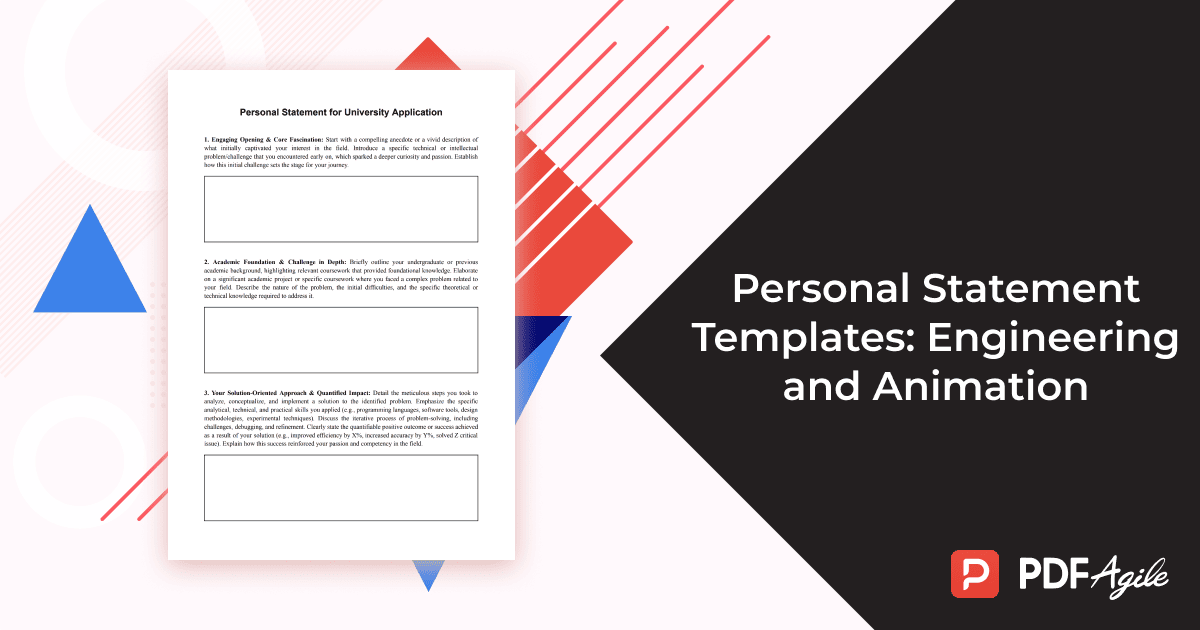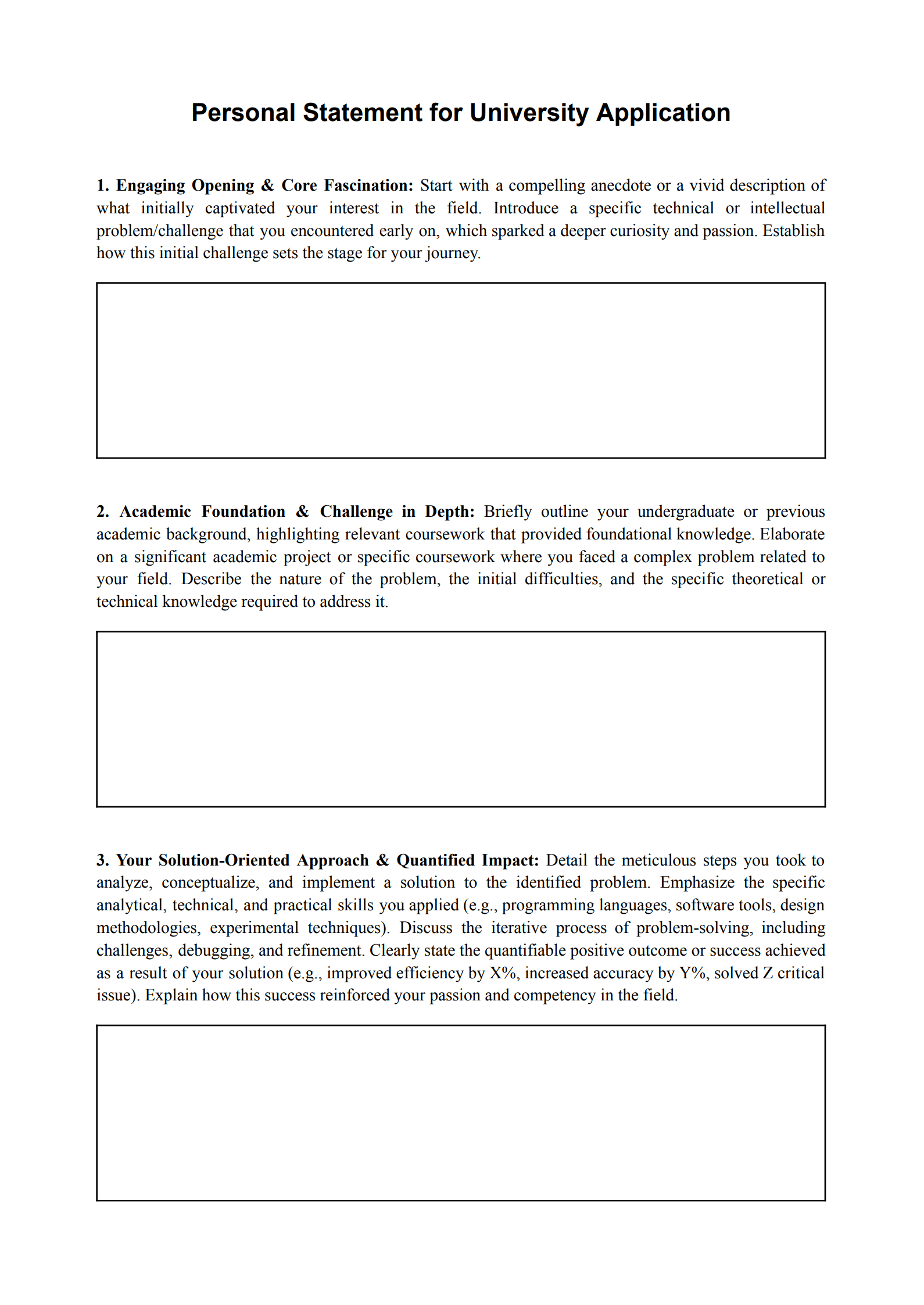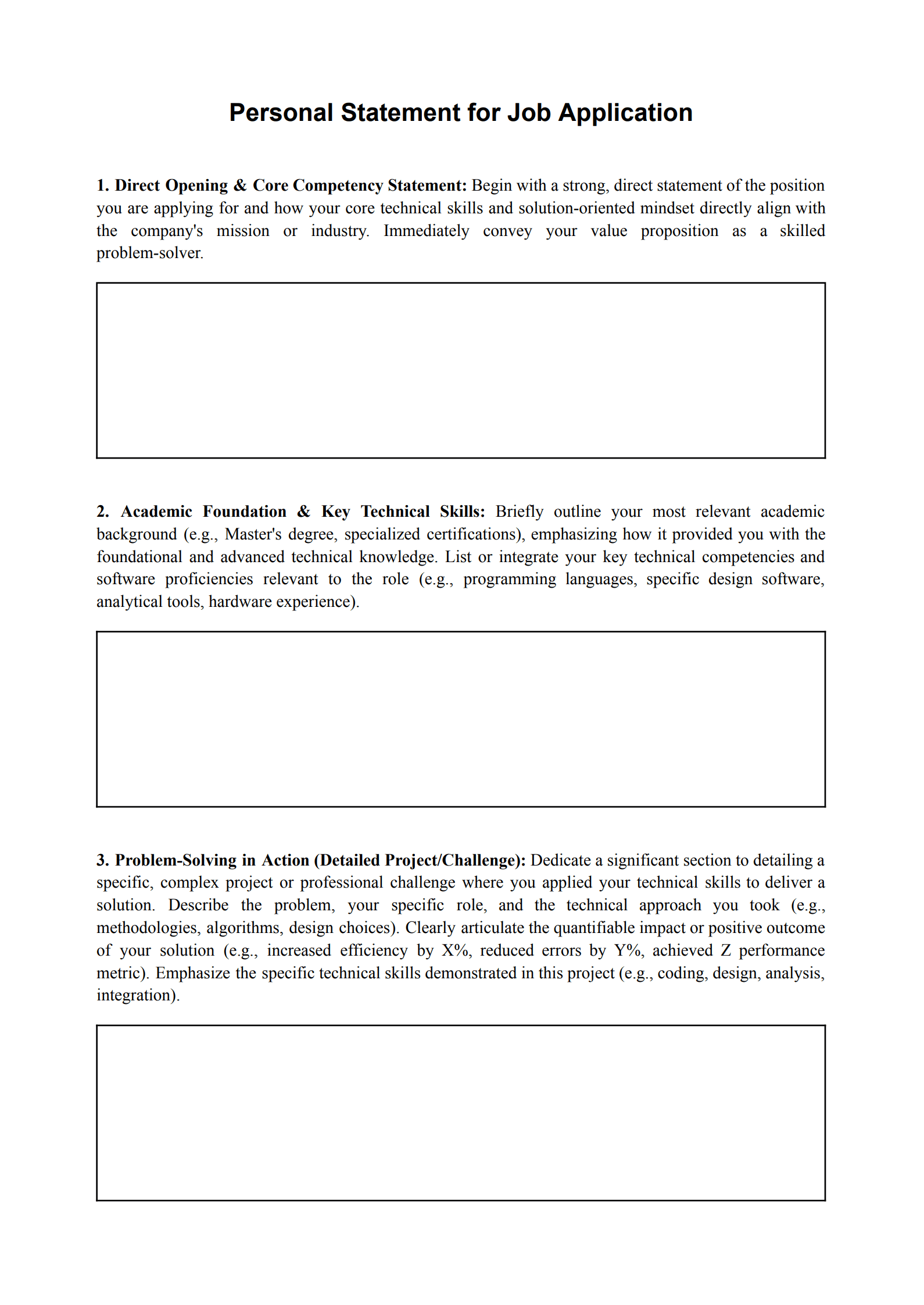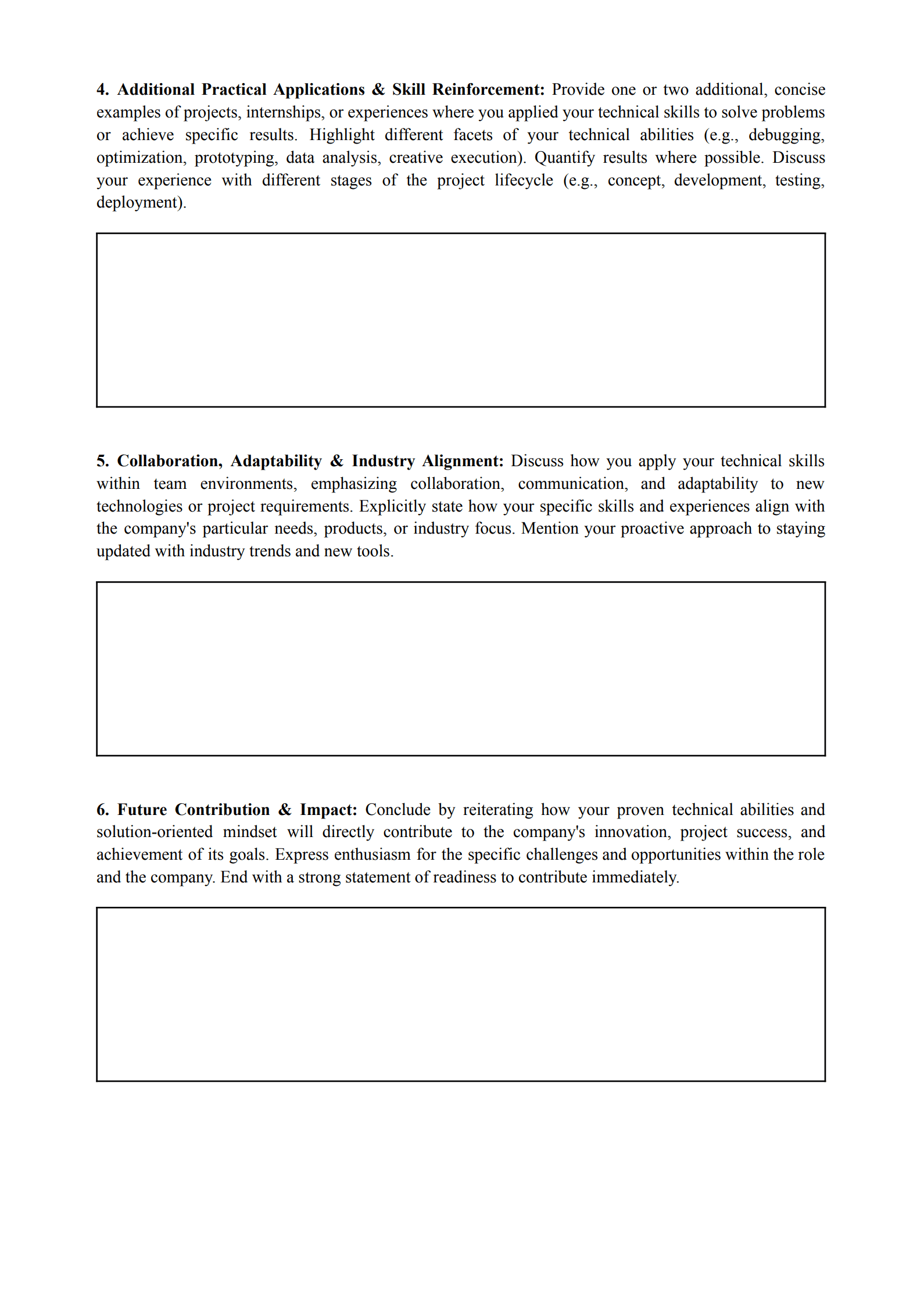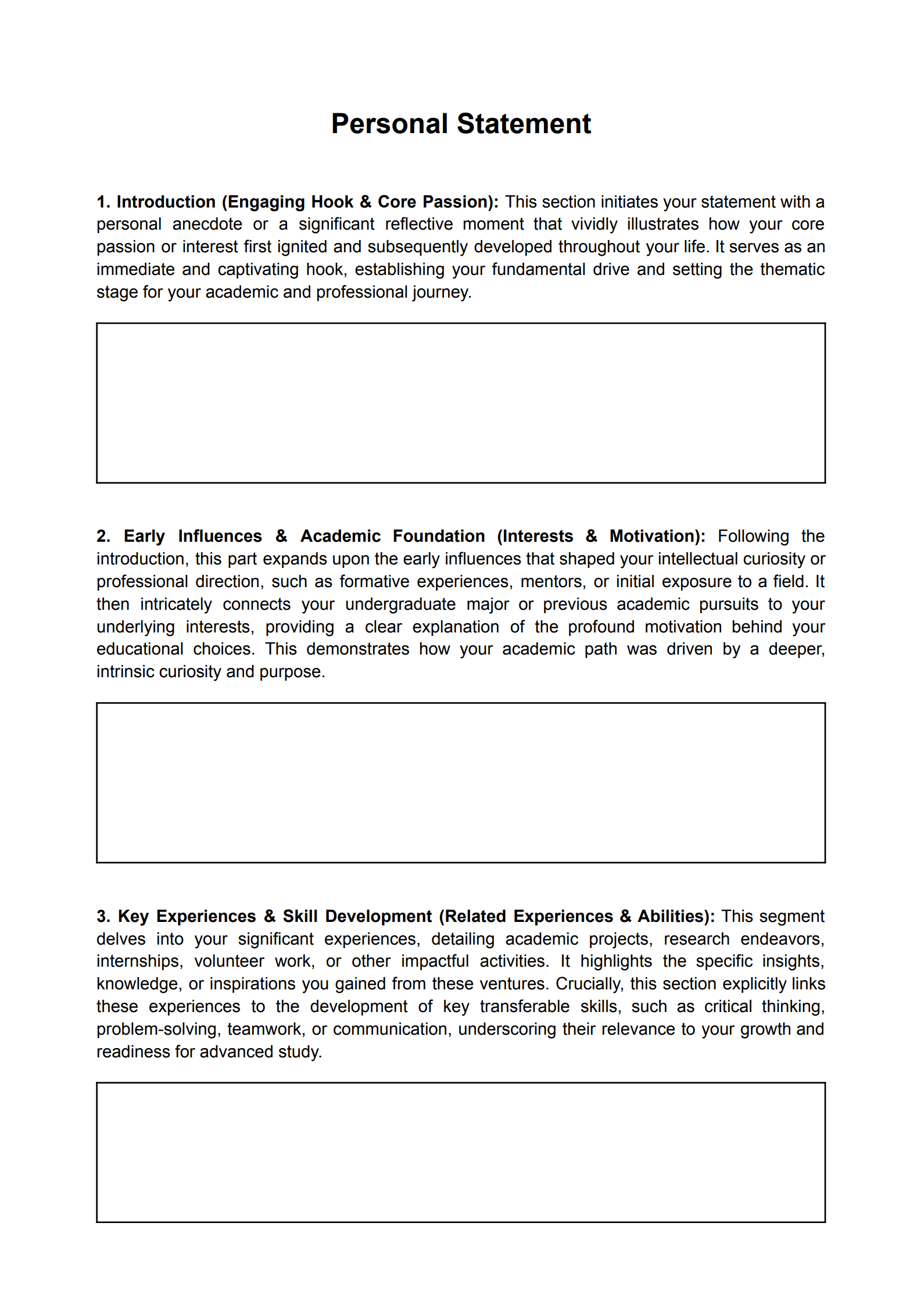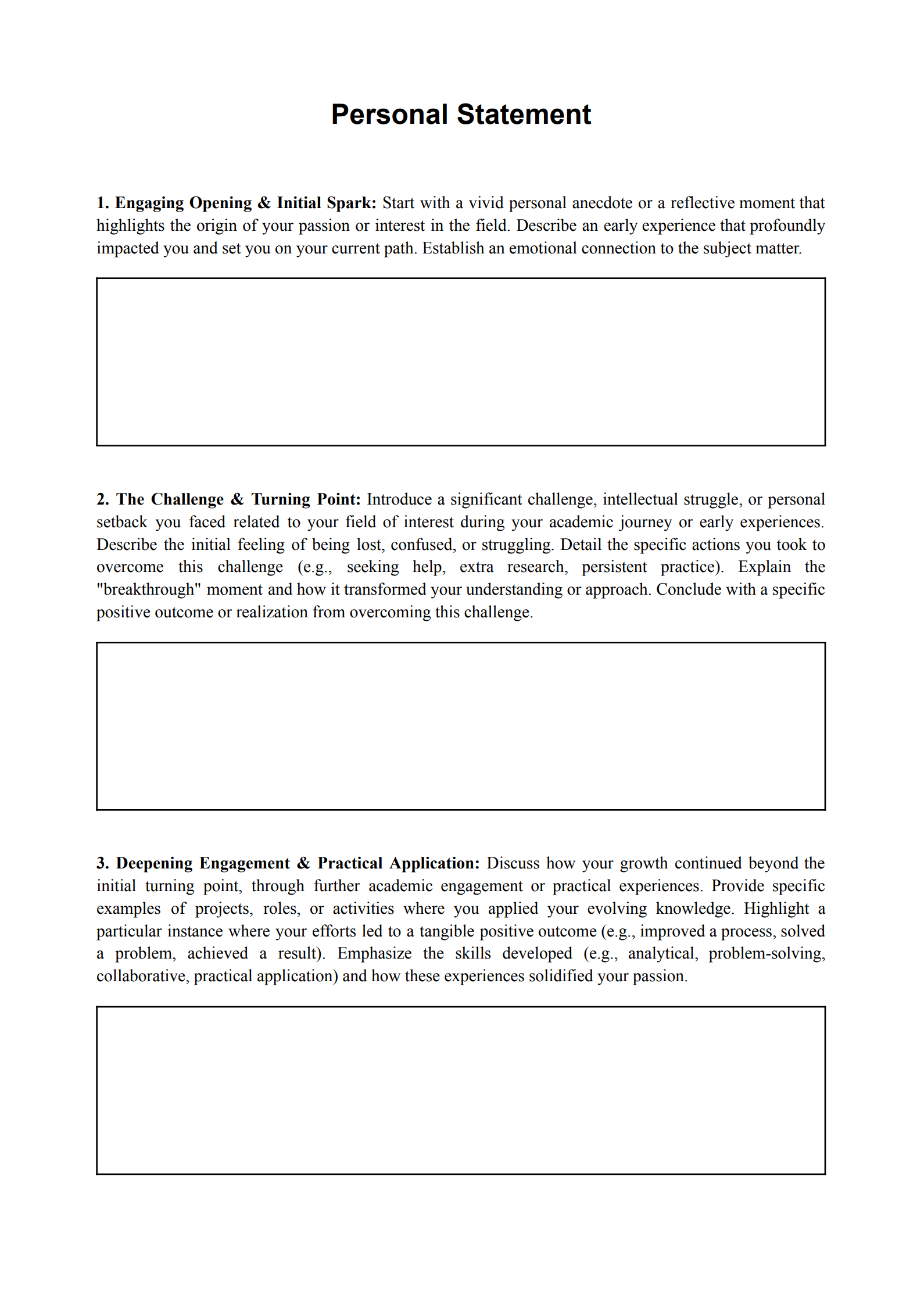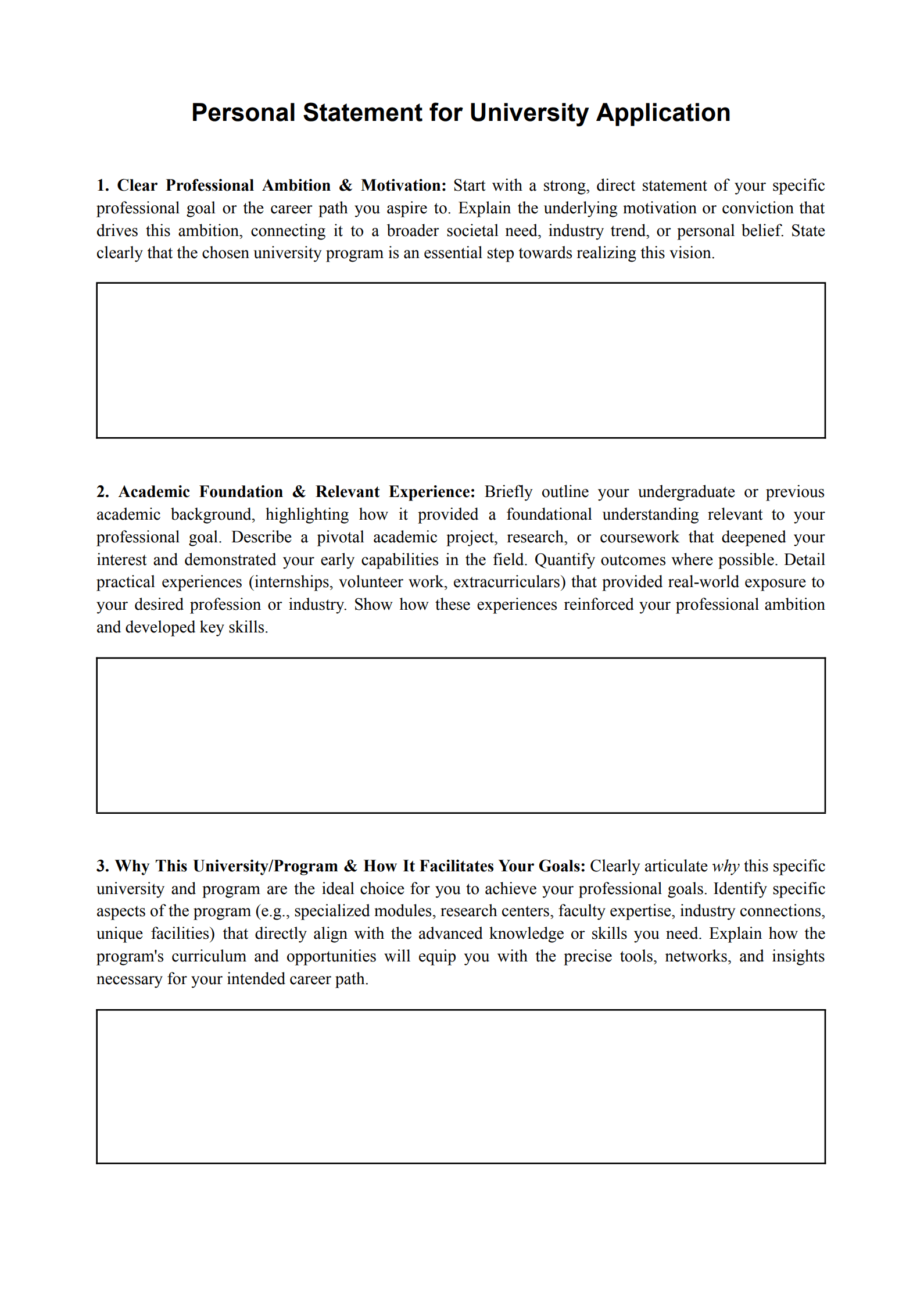In the competitive landscapes of university admissions and job applications, a personal statement is your prime opportunity to articulate not just what you know, but what you can do. Among the various approaches, the "Competency-Driven" style stands out as a particularly effective way to demonstrate your practical abilities, technical prowess, and solution-oriented mindset.
How Can Competency-Driven Style Optimize Your Personal Statement?
A personal statement characterized by a "Competency-Driven" style is fundamentally focused on showcasing your skills in action. It distinguishes itself by:
- Demonstrating Practical Ability: Instead of merely listing skills, it provides concrete examples of how you have applied your knowledge to solve real-world problems or complete complex tasks. This moves beyond theoretical understanding to prove genuine capability.
- Highlighting Problem-Solving Mindset: It frames your experiences around challenges you've encountered and the logical, systematic steps you took to overcome them. This reveals your analytical thinking and resilience.
- Providing Concrete Evidence: It relies heavily on specific projects, roles, or scenarios where your skills were put to the test, often including quantifiable results to illustrate the impact of your work.
- Showing Readiness for Practical Challenges: For both academic programs with applied components and job roles requiring immediate contribution, this style signals that you are prepared to tackle hands-on challenges and deliver tangible outcomes.
- Making the Statement Highly Relevant and Actionable: By directly linking your competencies to the demands of the program or position, it makes your application highly targeted and compelling, showing precisely how you fit.
This style optimizes your personal statement by creating a strong, evidence-based argument for your candidacy, making your application memorable and convincing.
Real-World Journeys: From Academia to Industry
To powerfully illustrate the "Competency-Driven" approach, let's examine two distinct professional trajectories. Our first example, Applicant A, is an individual with a strong foundation in Mechanical Engineering, whose passion for intricate mechanisms led them to pursue a Master's in Robotics Engineering. Their ultimate goal is to become a Robotics System Developer, building intelligent machines that solve complex problems.
Personal Statement for Master's in Robotics Engineering
The intricate dance of gears, the precise articulation of robotic arms, and the elegant efficiency of automated systems have captivated my imagination since childhood. I recall spending countless hours disassembling old electronics, not merely to break them, but to understand the hidden mechanisms that allowed them to function. This innate curiosity found its true calling during my undergraduate studies in Mechanical Engineering, where I encountered a particularly challenging problem: designing a compact, efficient robotic gripper capable of handling objects of varying geometries without requiring complex sensor feedback. This wasn't just an academic exercise; it was a real-world dilemma faced in small-scale manufacturing. The initial designs were either too bulky, too slow, or lacked the necessary dexterity. This technical hurdle, far from being a deterrent, ignited a profound passion within me for the iterative process of problem identification, solution conceptualization, and rigorous implementation that defines robotics engineering.
My undergraduate curriculum provided the foundational tools to approach such challenges. Courses in kinematics and dynamics equipped me with the theoretical understanding of robot motion, while solid mechanics and materials science provided insights into structural integrity and component selection. I became proficient in CAD software like SolidWorks and Fusion 360, translating abstract concepts into tangible designs. However, the true test came in practical application. For a final year project, our team was tasked with developing an automated sorting system for small industrial components. The core problem was the reliable identification and precise manipulation of irregularly shaped items moving on a conveyor belt. My specific role involved designing the robotic arm's end-effector and programming its control logic. I spent weeks iterating on gripper designs, experimenting with different compliance mechanisms and finger geometries to ensure a secure yet gentle grasp. Simultaneously, I delved into ROS (Robot Operating System) and Python, learning to integrate vision system feedback with actuator commands. The initial attempts were fraught with errors – dropped components, misidentifications, and slow cycle times. This period of intense debugging and refinement, often extending late into the night, was invaluable. It taught me the critical importance of robust error handling, precise calibration, and the iterative nature of engineering design. We eventually achieved a system that could sort 95% of components accurately at a rate of 30 items per minute, exceeding our initial target by 10%. This success was not just about meeting a project deadline; it was about the profound satisfaction of seeing a complex problem yield to a well-engineered solution, reinforcing my conviction that robotics is my destined path.
Beyond academic projects, I actively sought opportunities to deepen my practical skills. During a summer internship at [Fictional Robotics Startup Name], I contributed to the development of a mobile inspection robot for confined spaces. My primary responsibility was integrating various sensors (Lidar, ultrasonic, IMU) and developing navigation algorithms. I encountered the challenge of sensor fusion in noisy environments, where conflicting data led to unreliable localization. I researched Extended Kalman Filters (EKF) and implemented a custom EKF algorithm in C++ to fuse data from multiple sensors, significantly improving the robot's positional accuracy by 20% in cluttered environments. This hands-on experience with real-world robotic systems and complex programming solidified my competency in developing robust and reliable robotic solutions. Furthermore, my participation in the university's Robotics Club allowed me to collaborate on smaller, passion-driven projects, such as building a competitive sumo robot, where I gained practical experience in rapid prototyping, motor control, and embedded systems programming.
My decision to pursue a Master's in Robotics Engineering is driven by a clear understanding of the advanced knowledge and specialized skills required to excel as a Robotics System Developer. While my undergraduate degree provided a strong foundation, I recognize the need for deeper expertise in areas such as advanced control theory, machine learning for robotics, human-robot interaction, and complex system integration – all core components of your distinguished program at [University Name]. I am particularly drawn to [University Name]'s [mention a specific lab, e.g., "Robotics and Automation Lab"] and the groundbreaking work of Professor [mention a specific professor whose research aligns, e.g., "Dr. Emily Chen's research on dexterous manipulation"]. I am eager to leverage your program's blend of theoretical rigor and practical application, including its state-of-the-art facilities and opportunities for interdisciplinary research, to develop the comprehensive toolkit required to design, build, and deploy the next generation of intelligent robotic systems.
My long-term vision is to contribute to the development of autonomous robotic systems that can safely and efficiently perform complex tasks in unstructured environments, whether in advanced manufacturing, logistics, or even exploration. I aim to be at the forefront of integrating AI and machine learning into robotic control, enabling robots to adapt and learn in dynamic settings. The Master's in Robotics Engineering at [University Name] represents the critical next step in realizing this ambitious yet vital professional journey, equipping me with the advanced competencies to solve the most challenging problems in robotics. I am prepared to dedicate myself fully to the rigorous demands of this program and am excited by the prospect of contributing to your vibrant academic community.
Personal Statement for Robotics System Developer
My professional drive is centered on the design, development, and deployment of intelligent robotic systems that solve complex real-world challenges, transforming industries through automation and innovation. As a highly skilled and solution-oriented Mechanical Engineer with a Master's in Robotics Engineering, I am eager to contribute my technical expertise and proven problem-solving abilities to [Company Name]'s pioneering work in robotics. My background is uniquely aligned with your mission to [mention something specific about the company's mission, e.g., "create agile, mobile robots," "advance industrial automation," "optimize logistics through robotics"].
My academic foundation and practical experiences have meticulously prepared me to excel as a Robotics System Developer. My Master's in Robotics Engineering provided me with advanced knowledge in areas such as robot kinematics and dynamics, advanced control theory, sensor fusion, and machine learning for robotics. This academic rigor is complemented by a deep understanding of mechanical design principles, embedded systems, and robust software development.
My key competencies and solution-oriented approach are demonstrated through specific projects:
- Autonomous Navigation & Sensor Fusion (Problem: Unreliable Localization in Cluttered Environments): During my Master's program, I led a project focused on improving the autonomous navigation of a mobile robot in dynamic, cluttered indoor environments. The primary challenge was integrating noisy sensor data from Lidar, ultrasonic, and IMU units to achieve precise localization. I designed and implemented a custom Extended Kalman Filter (EKF) algorithm in C++ within the ROS (Robot Operating System) framework to fuse this disparate data. This solution significantly improved the robot's positional accuracy by 20% compared to traditional odometry, enabling more reliable path planning and obstacle avoidance. This project honed my skills in advanced control systems, sensor integration, and robust software development for autonomous platforms.
- Dexterous Manipulation & End-Effector Design (Problem: Handling Varied Objects with Limited Feedback): In my undergraduate capstone project, I was responsible for designing and programming a robotic gripper for an automated industrial sorting system. The challenge was to handle irregularly shaped components with varying stiffness without requiring complex vision feedback for each pick. I engineered a novel compliant gripper mechanism using flexible materials and optimized its finger geometry through multiple CAD iterations and simulations. I then developed the control logic in Python, integrating basic force feedback for adaptive grasping. The implemented solution achieved a 95% accuracy rate in sorting components at 30 items per minute, exceeding the project target and demonstrating my ability to design and optimize mechanical systems for precise manipulation tasks.
- System Integration & Real-time Control (Problem: Synchronizing Disparate Robotic Subsystems): During a summer internship at [Fictional Robotics Startup Name], I was tasked with integrating multiple robotic subsystems – including a robotic arm, a mobile base, and a vision system – into a cohesive inspection platform. The challenge involved ensuring real-time communication and synchronized control between these diverse components. I developed custom communication protocols and utilized ROS nodes to manage data flow and command execution, resulting in a fully integrated system that reduced inspection cycle time by 15%. This experience solidified my proficiency in system architecture, real-time control, and troubleshooting complex robotic setups.
- Software Development for Robotics: I am highly proficient in C++ and Python for robotics application development, with experience in developing control algorithms, implementing sensor drivers, and creating user interfaces. My expertise extends to utilizing ROS, Gazebo for simulation, and various Adobe Creative Suite tools for technical documentation and presentation.
I am particularly drawn to [Company Name]'s [mention something specific about the company, e.g., "innovative approach to legged locomotion," "leadership in industrial automation solutions," "commitment to human-robot collaboration"]. My blend of theoretical knowledge in robotics, hands-on experience in developing complex systems, and a proven track record of solving challenging engineering problems makes me an ideal candidate to contribute to your team. I am eager to apply my skills in [mention 2-3 key skills relevant to the job] to help [Company Name] continue to push the boundaries of what is possible in robotics.
Our second example, Applicant B, is driven by a lifelong fascination with bringing static images to life. Their journey began with undergraduate studies in Animation, evolving into a focused aspiration to become a Motion Designer in the dynamic digital entertainment industry. Their statements showcase a clear ability to blend artistic vision with technical execution to create captivating visual experiences.
Personal Statement for Master's in Motion Graphics & Visual Effects
From the earliest days of doodling flip-books, I've been captivated by the magic of bringing static images to life, of imbuing them with emotion, narrative, and dynamic energy. This fascination crystallized during my undergraduate studies in Animation, where I encountered a particularly compelling creative challenge: how to convey the abstract concept of "growth" through purely visual motion, without relying on dialogue or explicit narrative. My initial attempts felt rudimentary, lacking the fluidity and emotional resonance I envisioned. The elements moved, but they didn't express. This technical and artistic hurdle, far from being a deterrent, ignited a profound passion within me for the intricate process of problem identification, creative conceptualization, and meticulous execution that defines motion design.
My undergraduate curriculum provided the foundational tools to approach such challenges. Courses in 2D and 3D animation principles equipped me with an understanding of timing, spacing, and squash-and-stretch, while graphic design and visual storytelling honed my compositional skills. I became proficient in software like Adobe After Effects, Photoshop, Illustrator, and gained foundational knowledge in Cinema 4D. However, the true test came in practical application. For a final year project, our team was tasked with creating a 60-second animated short film that explored a non-linear narrative. My specific role involved developing the opening sequence's motion graphics, which needed to visually establish the film's abstract themes and emotional tone. The core problem was translating complex emotional states into dynamic, non-representational motion. I spent weeks experimenting with particle systems, abstract shapes, and kinetic typography, pushing the boundaries of what After Effects could do. The initial attempts felt disjointed, failing to evoke the intended feeling. This period of intense iteration and artistic refinement, often extending late into the night, was invaluable. It taught me the critical importance of visual rhythm, color theory in conveying mood, and the iterative nature of creative problem-solving. We eventually produced an opening sequence that, according to audience feedback, successfully immersed viewers in the film's emotional landscape, contributing to the short film winning the "Best Experimental Animation" award at the university's annual film festival. This success was not just about winning an award; it was about the profound satisfaction of seeing a complex abstract concept yield to a well-crafted motion design solution, reinforcing my conviction that motion graphics is my destined path.
Beyond academic projects, I actively sought opportunities to deepen my practical skills and explore diverse applications of motion design. During a summer internship at [Fictional Digital Agency Name], I contributed to creating animated social media advertisements for various clients. My primary responsibility was to develop short, engaging motion graphics that captured product essence in under 15 seconds. I encountered the challenge of optimizing file sizes for web delivery while maintaining visual fidelity. I researched various compression techniques and rendering settings, successfully reducing file sizes by an average of 30% without noticeable quality loss, leading to faster load times and improved ad performance. This hands-on experience with real-world client briefs and technical optimization solidified my competency in developing effective and efficient motion design solutions for digital platforms. Furthermore, my freelance work creating animated logos and explainer videos for small businesses allowed me to hone my client communication skills, project management, and ability to translate abstract ideas into clear, compelling visual narratives.
My decision to pursue a Master's in Motion Graphics & Visual Effects is driven by a clear understanding of the advanced knowledge and specialized skills required to excel as a Motion Designer in the rapidly evolving digital entertainment industry. While my undergraduate degree provided a strong foundation, I recognize the need for deeper expertise in areas such as advanced 3D animation, procedural animation, real-time rendering, interactive motion graphics, and pipeline integration – all core components of your distinguished program at [University Name]. I am particularly drawn to [University Name]'s [mention a specific lab or studio, e.g., "Advanced Visuals Lab"] and the groundbreaking work of Professor [mention a specific professor whose research aligns, e.g., "Dr. Alex Lee's research on generative motion design"]. I am eager to leverage your program's blend of artistic innovation and technical rigor, including its state-of-the-art facilities and opportunities for collaborative projects with other creative disciplines, to develop the comprehensive toolkit required to create truly immersive and impactful motion experiences.
My long-term vision is to contribute to the cutting edge of digital entertainment, specializing in creating dynamic motion graphics for interactive experiences, game cinematics, and immersive storytelling. I aim to be at the forefront of integrating emerging technologies like AR/VR into motion design workflows, pushing the boundaries of visual communication and user engagement. The Master's in Motion Graphics & Visual Effects at [University Name] represents the critical next step in realizing this ambitious yet vital professional journey, equipping me with the advanced competencies to solve the most challenging creative and technical problems in digital entertainment. I am prepared to dedicate myself fully to the rigorous demands of this program and am excited by the prospect of contributing to your vibrant academic community.
Personal Statement for Motion Designer
My professional drive is centered on transforming concepts into captivating visual experiences, leveraging dynamic motion graphics to tell compelling stories and engage audiences in the digital entertainment landscape. As a highly skilled and solution-oriented Motion Designer with a Master's in Motion Graphics & Visual Effects, I am eager to contribute my creative vision and technical expertise to [Company Name]'s innovative projects. My background is uniquely aligned with your mission to [mention something specific about the company's mission, e.g., "create immersive game worlds," "produce groundbreaking animated series," "deliver visually stunning commercials"].
My academic foundation and practical experiences have meticulously prepared me to excel as a Motion Designer. My Master's in Motion Graphics & Visual Effects provided me with advanced knowledge in areas such as advanced 3D animation, procedural design, compositing, and real-time rendering pipelines. This academic rigor is complemented by a deep understanding of animation principles, visual storytelling, and efficient workflow optimization.
My key competencies and solution-oriented approach are demonstrated through specific projects:
- Immersive Storytelling & Visual Development (Problem: Conveying Abstract Themes for a Short Film): During my Master's program, I led the motion graphics development for an experimental animated short film. The core challenge was to visually establish the film's abstract themes and emotional tone in its opening sequence without dialogue. I designed and animated a complex sequence using abstract shapes, particle systems, and kinetic typography in After Effects and Cinema 4D. This solution successfully immersed viewers in the film's emotional landscape, contributing to the short film winning the "Best Experimental Animation" award at a university festival and receiving overwhelmingly positive audience feedback for its visual impact. This project honed my skills in conceptualizing and executing visually rich narratives.
- Efficient Asset Creation & Optimization (Problem: Delivering High-Quality Animated Ads with File Size Constraints): During a summer internship at [Fictional Digital Agency Name], I was responsible for creating animated social media advertisements for various clients. The challenge involved producing high-quality motion graphics that were visually engaging yet optimized for rapid web delivery. I researched and implemented advanced compression techniques and rendering settings, successfully reducing average file sizes by 30% without compromising visual fidelity. This optimization led to faster load times and an estimated 15% increase in ad click-through rates for several campaigns. This experience solidified my proficiency in efficient workflow management and technical optimization for digital platforms.
- Interactive Motion Graphics & UI Animation (Problem: Enhancing User Engagement in a Prototype Application): In a collaborative project during my Master's, I was tasked with designing interactive motion graphics for a prototype educational application. The challenge was to create intuitive and engaging UI animations that provided clear feedback and enhanced the user experience. I developed a series of micro-interactions and transitions in After Effects and integrated them into the application's prototype using Lottie/JSON animations. User testing revealed that these animations improved perceived responsiveness by 20% and significantly enhanced user satisfaction, demonstrating my ability to apply motion design principles to improve user experience and interface design.
- Software Proficiency & Creative Tools: I am an expert in Adobe Creative Suite, including After Effects, Photoshop, Illustrator, and Premiere Pro. I have strong proficiency in Cinema 4D for 3D modeling and animation, and foundational knowledge in Maya. My skills extend to compositing, color grading, and preparing final assets for various digital outputs. I am also adept at understanding and integrating into existing production pipelines.
I am particularly drawn to [Company Name]'s [mention something specific about the company, e.g., "commitment to pushing visual boundaries in gaming," "innovative approach to character animation," "reputation for cinematic storytelling"]. My blend of advanced academic knowledge in motion graphics, hands-on experience in developing visually stunning and optimized digital content, and a proven track record of solving creative and technical challenges makes me an ideal candidate to contribute to your team. I am eager to apply my skills in [mention 2-3 key skills relevant to the job] to help [Company Name] continue to create unforgettable digital entertainment experiences.
Both Applicant A and Applicant B's narratives, while operating in vastly different domains, powerfully exemplify how the "Competency-Driven" style can effectively convey their practical skills, problem-solving prowess, and readiness for demanding roles in their respective fields.
Why Did Applicant B's Statements Work?
Let's dissect why Applicant B's personal statements, crafted in the "Competency-Driven" style, were particularly effective for both university and job applications.
For the University Application (Problem-Solution Passion):
Applicant B's university personal statement for a Master's in Motion Graphics & Visual Effects immediately established a core fascination: "the magic of bringing static images to life." This set an engaging, passionate tone. The statement then introduced a specific creative and technical challenge from their undergraduate studies: "how to convey the abstract concept of 'growth' through purely visual motion, without relying on dialogue or explicit narrative." This framed their learning journey around a concrete problem.
The narrative meticulously detailed their solution-oriented approach. It wasn't just about using software; it was about "spending weeks experimenting with particle systems, abstract shapes, and kinetic typography," pushing creative boundaries. The "intense iteration and artistic refinement" highlighted their dedication and resilience. The impact was clear and quantifiable: the opening sequence successfully immersed viewers and contributed to the short film winning the "Best Experimental Animation" award, demonstrating their ability to translate abstract concepts into compelling, award-winning motion design.
Furthermore, the statement showcased broader practical experiences. An internship involved optimizing social media ads, where they successfully reduced file sizes by an average of 30% without quality loss, leading to faster load times and improved ad performance. This demonstrated not only technical proficiency but also an understanding of efficiency and audience engagement. Freelance work further emphasized client communication and project management. The "Why this program?" section precisely articulated the need for advanced 3D animation, real-time rendering, and pipeline integration, directly aligning with the program's core components and specific faculty research, proving a strategic fit for their continued technical growth.
For the Job Application (Skills and Solution-Oriented):
Applicant B's job application personal statement for a Motion Designer position seamlessly transitioned into the "Skills and Solution-Oriented" style. It began with a direct statement of their professional drive: "transforming concepts into captivating visual experiences," immediately positioning them as a skilled problem-solver in digital entertainment.
The statement then leveraged their Master's in Motion Graphics & Visual Effects, emphasizing advanced knowledge in areas like 3D animation, procedural design, and compositing. It then presented key competencies through specific projects:
Immersive Storytelling & Visual Development: The short film project was re-framed around the challenge of "conveying abstract themes." The solution highlighted their use of After Effects and Cinema 4D to create a sequence that "successfully immersed viewers" and won an award, showcasing their ability to conceptualize and execute visually rich narratives.
Efficient Asset Creation & Optimization: The internship experience was presented as solving the problem of "delivering high-quality animated ads with file size constraints." The solution involved "advanced compression techniques," resulting in a 30% file size reduction and an estimated 15% increase in ad click-through rates, demonstrating both technical optimization and direct impact on marketing performance.
Interactive Motion Graphics & UI Animation: A new project example was introduced, focusing on "enhancing user engagement in a prototype application." Their solution involved "micro-interactions and transitions in After Effects integrated via Lottie/JSON," leading to a 20% improvement in perceived responsiveness and enhanced user satisfaction. This highlighted their versatility in applying motion design to user experience.
The statement also clearly listed their expert software proficiency (Adobe Creative Suite, Cinema 4D, Maya) and discussed their collaborative approach. It concluded by explicitly aligning their skills with the company's mission (e.g., "pushing visual boundaries in gaming"), making a strong case for their immediate and valuable contribution.
Conclusion
The "Competency-Driven" approach to personal statements, as powerfully demonstrated by Applicant A and Applicant B, offers a strategic framework for articulating your practical abilities and problem-solving prowess. It moves beyond simply stating what you know, instead inviting the reader to understand how you apply your skills to achieve tangible results.
Whether you're applying for a university program or a job, our comprehensive personal statement templates provide a step-by-step guide to help you craft your own compelling narrative. Each template is designed to walk you through the process, ensuring you highlight your technical abilities, demonstrate your solution-oriented mindset, and articulate your practical achievements with precision and impact. Explore our range of templates, specifically designed for fields like Engineering and Animation, to find the perfect fit for your story and unlock your full application potential.
Free Download: Your Customizable Personal Statement Templates
Need a quick and easy way to create professional Personal Statement Templates? Download our free, customizable templates by clicking the Use Template button on this page. Simply add your specific information and print them out.
